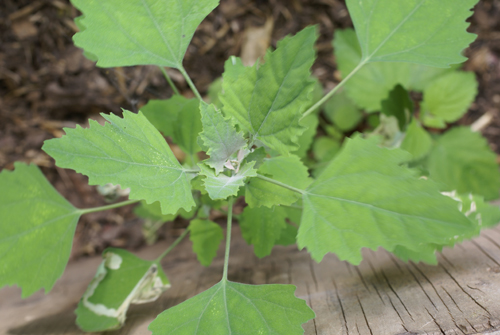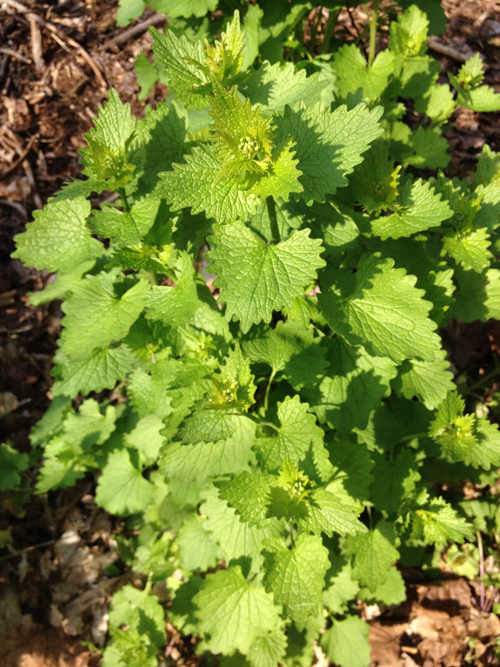You may be surprised to find that some of the weeds you’ve been battling in your yard and garden should end up on your dinner plate, not the trash can. Edible weeds are everywhere, so why not take out your vengeance on them by eating them rather than tossing them? Read on to find out which five common weeds you didn’t know you could eat, plus wild food recipes!

New from Craftsy: Online gardening classes!
Browse our growing selection of online gardening classes, covering the techniques you told us you’d love to learn most, from growing heirloom tomatoes to garden design.
1. Plantain
Plantain is the king of edible weeds. Not only can you use every part of the plant, but there are so many uses for it! Plantain can be eaten, made into tea, and used medicinally. It thrives in any soil type and practically any conditions, making it one of the most common weeds. You’ll find plantain popping up in your lawn, your garden, even in cracks in the sidewalk!
How to eat plantain:
- Eat it raw: young leaves can be eaten in salads.
- Cook it: sauté plantain in butter with salt, pepper and garlic for a side dish.
- Put it in a soup: young leaves are great in soups and stews.
- Make tea: dry and crush the leaves, then steep them in hot water for an herbal tea.
- Use it as medicine: plantain can be crushed and made into a salve to help heal cuts and bruises, and take the sting out of insect bites

2. Dandelion
Okay, maybe this is an edible weed you did know you could eat, but it’s so good it made the list anyway. Each and every part of the dandelion can be eaten, and since it’s chock full of vitamins and minerals, it should be eaten.
How to eat dandelion:
- Eat it raw: put the greens and flowers in a salad.
- Cook it: sauté the greens in butter and seasonings, stir-fry, or steam them, bread and fry the flowers for a crunchy treat.
- Make tea: rinse the roots and roast them in the oven for a strong tea comparable to coffee.
- Make wine: steep only the yellow flower petals in boiling water and add sugar and yeast to make a delicious wine.
- Make jelly: use the flower petals to make dandelion jelly.

Photo licensed via Creative Commons by Flickr member Jason Hollinger
3. Purslane
It’s almost impossible to get rid of and grows everywhere, so why not start harvesting and eating it? You’ll find purslane growing on the edges of gardens and lawns. It has succulent-type leaves that are best eaten when young and supple.
Purslane is peppery, crisp and lemony, and you may have seen it sitting atop a pricey salad at a fancy restaurant. This weed is not only delicious, it’s good for you. It tops the charts in plants highest in vitamin E and omega 3 fatty acids.
How to eat purslane:
- Eat it raw: put it in a salad, use it in place of lettuce in a sandwich or burger.
- Cook it: blanch it and add it to a stir fry, substitute it for spinach in recipes.
- Blend it: make purslane pesto by blending it with basil, garlic, olive oil and nuts in a food processor.

4. Lambsquarters (aka pigweed aka goosefoot)
A weed of many names, lambsquarters is very common in the U.S. and Canada and can be seen growing on roadsides, in gardens, and near water. The edible parts are the leaves, stems, flowers, and seeds. Its taste is similar to chard, spinach, and collard greens.
How to eat lambsquarters:
- Eat it raw: eat it in small quantities raw because it contains some oxalic acid; lambsquarters is great in a salad.
- Cook it: cooking lambsquarters removes the acid and makes the leaves more palatable; steam, sauté or use if for making soup and stew.
- Blend it: lambsquarters can be tossed in the blender or juicer to add a nutrient punch to tasty beverages.

5. Garlic mustard
Garlic mustard is the bane of most homeowners’ existence. This voracious weed invades any land it crosses and quickly takes over gardens and lawns. You’ll also find this invasive plant growing thickly in parks, roadsides and next to forests. Now that you know it’s edible, you can get your revenge by ripping it up and eating it. Garlic mustard has a strong, bitter flavor that lessens with cooking.
How to eat garlic mustard:
- Eat it raw: add it to a salad for a spicy flavor, crush the roots and blend with vinegar for a spicy horseradish-like sauce.
- Cook it: steam, simmer or sauté it until wilted.
- Blend it: make garlic mustard pesto by mixing it with olive oil, nuts and Parmesan cheese in a food processor.
Foraging do’s and don’ts
These are just the five most common edible weeds out there, the great outdoors is full of edible plants and a good guide book can point you to a whole array of nature’s bounty.
Before you head out the door with your foraging basket and scissors, take note of some of the do’s and don’ts of foraging.
Do:
- Learn about look-alikes so you can be sure you’re harvesting the correct plant.
- Get permission before you pick. Your neighbors may not be happy to see you foraging in their backyard, and it’s illegal to forage in many parks. Be sure to get the OK before you pick.
- Cross reference with at least three foraging guides before eating.
- Take it easy your first time trying a new foraged food, just because it’s edible doesn’t mean your belly will like it.
- Take a buddy — not only is it more fun to forage with a friend, it’s safer too.
Don’t:
- Harvest from roadsides.
- Harvest from areas that may have been sprayed with herbicides and pesticides.
- Take too much — leave enough so the plants can reproduce and other people or animals can enjoy the bounty as well.
- Pick or destroy protected plants.
- Harvest plants that look unhealthy — diseased plants or those covered in fungus or pests aren’t good for you.
This post is not a guide to foraging and doesn’t include information on how to identify these edible weeds for a reason. There are many guides both online and in books to help you identify wild edibles, use them (cross reference at least three!) to be absolutely sure you have positively identified a plant before eating it.
This post is meant for educational purposes to open your eyes to the world of weeds sitting right in your backyard. If you do choose to go foraging for weeds, it would be wise to take along someone who knows how to positively identify them, or several foraging guide books to help you make a proper identification.

Share tips, start a discussion or ask one of our experts or other students a question.
No Responses to “Weed It or Eat It? 5 Weeds You Probably Didn't Know You Could Eat”